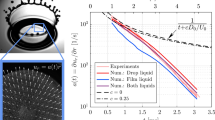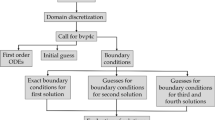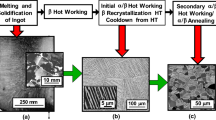Abstract
Ionic liquids (ILs) are widely adopted as lubricating materials in engineering fields for steel sliding contacts, and the adsorption structure and kinematic state of friction surfaces are crucial for understanding the improvement of tribological properties in experiments. In this study, we employed molecular dynamics methods to examine the structure and shear dynamics of five ILs with the same cationic triethanolamine paired with carboxylate anions of different alkyl chain length, confined between two crystalline iron surfaces. The results show that the chain length of anions influence the quantity of hydrogen bonds formed, the distribution on the iron surfaces, the thickness of the adsorption layers during the sliding process and the overall motion state. Under elastohydrodynamic lubrication conditions, ILs with longer alkyl chain exhibit less friction on a macroscopic scale due to the weaker hydrogen bonds between the anions and cations, the formation of thicker adsorption layers between sliding surfaces, and the overall pronounced layering phenomenon. These atomic insights into the structure and state of motion during friction can help promote the use of ILs as lubricating materials in engineering applications.
Graphical Abstract










Similar content being viewed by others
Data Availability
All experimental data are available upon request.
References
Luo, J., Zhou, X.: Superlubricitive engineering—future industry nearly getting rid of wear and frictional energy consumption. Friction 8, 643–665 (2020). https://doi.org/10.1007/s40544-020-0393-0
Holmberg, K., Erdemir, A.: Influence of tribology on global energy consumption, costs and emissions. Friction 5, 263–284 (2017). https://doi.org/10.1007/s40544-017-0183-5
Ye, C., Liu, W., Chen, Y., Yu, L.: Room-temperature ionic liquids: a novel versatile lubricant. Chem. Commun. 21, 2244–2245 (2001). https://doi.org/10.1039/b106935g
Song, J.: Research progress of ionic liquids as lubricants. ACS Omega 6, 29345–29349 (2021). https://doi.org/10.1021/acsomega.1c04512
Zhou, Y., Qu, J.: Ionic liquids as lubricant additives: a review. ACS Appl. Mater. Interfaces 9, 3209–3222 (2017). https://doi.org/10.1021/acsami.6b12489
Palacio, M., Bhushan, B.: A Review of ionic liquids for green molecular lubrication in nanotechnology. Tribol. Lett. 40, 247–268 (2010). https://doi.org/10.1007/s11249-010-9671-8
Qu, J., Truhan, J.J., Dai, S., Luo, H., Blau, P.J.: Ionic liquids with ammonium cations as lubricants or additives. Tribol. Lett. 22, 207–214 (2006). https://doi.org/10.1007/s11249-006-9081-0
Dong, R., Yu, Q., Bai, Y., Wu, Y., Ma, Z., Zhang, J., et al.: Towards superior lubricity and anticorrosion performances of proton-type ionic liquids additives for water-based lubricating fluids. Chem. Eng. J. 383, 123201 (2020). https://doi.org/10.1016/j.cej.2019.123201
Cai, M., Yu, Q., Liu, W., Zhou, F.: Ionic liquid lubricants: when chemistry meets tribology. Chem. Soc. Rev. 49, 7753–7818 (2020). https://doi.org/10.1039/d0cs00126k
Somers, A., Howlett, P., MacFarlane, D., Forsyth, M.: A review of ionic liquid lubricants. Lubricants 1, 3–21 (2013). https://doi.org/10.3390/lubricants1010003
Yu, Q., Zhang, C., Dong, R., Shi, Y., Wang, Y., Bai, Y., et al.: Physicochemical and tribological properties of gemini-type halogen-free dicationic ionic liquids. Friction 9, 344–355 (2020). https://doi.org/10.1007/s40544-019-0348-5
Yao, M., Fan, M., Liang, Y., Zhou, F., Xia, Y.: Imidazolium hexafluorophosphate ionic liquids as high temperature lubricants for steel–steel contacts. Wear 268, 67–71 (2010). https://doi.org/10.1016/j.wear.2009.06.028
Chen, G., Zhang, C., Huang, Q., Yu, Q., Yang, Z., Zhou, C., et al.: Novel phosphate organic guanidine salt water-based additive with integrated anti-friction, anti-wear and anti-corrosion properties. Tribol. Lett. 70, 33 (2022). https://doi.org/10.1007/s11249-022-01577-4
Fang, H., Li, Y., Zhang, S., Ding, Q., Hu, L., Lu, K.: The superior lubricating performance and unique mechanism of oil-soluble protic ionic liquids with short alkyl chains. J. Colloid Interface Sci. 623, 257–266 (2022). https://doi.org/10.1016/j.jcis.2022.04.174
Fang, H., Li, Y., Zhang, S., Ding, Q., Hu, L.: Lubricating performances of oil-miscible trialkylanmmonium carboxylate ionic liquids as additives in PAO at room and low temperatures. Appl. Surf. Sci. 568, 150922 (2021). https://doi.org/10.1016/j.apsusc.2021.150922
Dong, R., Bao, L., Yu, Q., Wu, Y., Ma, Z., Zhang, J., et al.: Effect of electric potential and chain length on tribological performances of ionic liquids as additives for aqueous systems and molecular dynamics simulations. ACS Appl. Mater. Interfaces 12, 39910–39919 (2020). https://doi.org/10.1021/acsami.0c11016
Wang, Y., Wang, C., Zhang, Y., Huo, F., He, H., Zhang, S.: Molecular insights into the regulatable interfacial property and flow behavior of confined ionic liquids in graphene nanochannels. Small 15, 1804508 (2019). https://doi.org/10.1002/smll.201804508
David, A., Fajardo, O.Y., Kornyshev, A.A., Urbakh, M., Bresme, F.: Electrotunable lubricity with ionic liquids: the influence of nanoscale roughness. Faraday Discuss. 199, 279–297 (2017). https://doi.org/10.1039/c6fd00244g
Plimpton, S.: Fast parallel algorithms for short-range molecular dynamics. J. Comput. Phys. 117, 1–19 (1995). https://doi.org/10.1006/jcph.1995.1039
Martínez, L., Andrade, R., Birgin, E.G., Martínez, J.M.: PACKMOL: a package for building initial configurations for molecular dynamics simulations. J. Comput. Chem. 30, 2157–2164 (2009). https://doi.org/10.1002/jcc.21224
Ewen, J.P., Echeverri Restrepo, S., Morgan, N., Dini, D.: Nonequilibrium molecular dynamics simulations of stearic acid adsorbed on iron surfaces with nanoscale roughness. Tribol. Int. 107, 264–273 (2017). https://doi.org/10.1016/j.triboint.2016.11.039
Stukowski, A.: Visualization and analysis of atomistic simulation data with OVITO–the open visualization tool. Model. Simul. Mater. Sci. 18, 015012 (2010). https://doi.org/10.1088/0965-0393/18/1/015012
Dodda, L.S., de Vaca, I.C., Tirado-Rives, J., Jorgensen, W.L.: LigParGen web server: an automatic OPLS-AA parameter generator for organic ligands. Nucleic Acids Res. 45, 331–336 (2017). https://doi.org/10.1093/nar/gkx312
William, L., Jorgensen, D.S.M., Tirado-Rives, J.: development and testing of the OPLS all-atom force field on conformational energetics and properties of organic liquids. J. Am. Chem. Soc. 118, 11225–11236 (1996). https://doi.org/10.1021/ja9621760
Mendelev, M.I., Han, S., Srolovitz, D.J., Ackland, G.J., Sun, D.Y., Asta, M.: Development of new interatomic potentials appropriate for crystalline and liquid iron. Philos. Mag. 83, 3977–3994 (2003). https://doi.org/10.1080/14786430310001613264
Gusain, R., Bakshi, P.S., Panda, S., Sharma, O.P., Gardas, R., Khatri, O.P.: Physicochemical and tribophysical properties of trioctylalkylammonium bis(salicylato)borate (N888n-BScB) ionic liquids: effect of alkyl chain length. Phys. Chem. Chem. Phys. 19, 6433–6442 (2017). https://doi.org/10.1039/c6cp05990b
Huang, G., Fan, S., Ba, Z., Cai, M., Qiao, D.: Insight into the lubricating mechanism for alkylimidazolium phosphate ionic liquids with different alkyl chain length. Tribol. Int. 140, 105886 (2019). https://doi.org/10.1016/j.triboint.2019.105886
Zheng, Z., Liu, X., Yu, H., Chen, H., Feng, D., Qiao, D.: Insight into macroscale superlubricity of polyol aqueous solution induced by protic ionic liquid. Friction 10, 2000–2017 (2022). https://doi.org/10.1007/s40544-021-0563-8
Alenka Luzar, D.C.: Effect of environment on hydrogen bond dynamics in liquid water. Phys. Rev. Lett. 76, 928–931 (1996). https://doi.org/10.1103/PhysRevLett.76.928
Blanco-Díaz, E.G., Castrejón-González, E.O., Alvarado, J.F.J., Estrada-Baltazar, A., Castillo-Borja, F.: Rheological behavior of ionic liquids: analysis of the H-bond formation by molecular dynamics. J. Mol. Liq. 242, 265–271 (2017). https://doi.org/10.1016/j.molliq.2017.06.128
Ma, Y., Liu, Y., Su, H., Wang, L., Zhang, J.: Relationship between hydrogen bond and viscosity for a series of pyridinium ionic liquids: molecular dynamics and quantum chemistry. J. Mol. Liq. 255, 176–184 (2018). https://doi.org/10.1016/j.molliq.2018.01.121
Liang, H., Yin, T., Liu, M., Fu, C., Xia, X., Zou, S., et al.: Unravelling high-load superlubricity of ionic liquid analogues by in situ raman: incomplete hydration induced by competitive exchange of external water with crystalline water. J. Phys. Chem. Lett. 14, 453–459 (2023). https://doi.org/10.1021/acs.jpclett.2c03667
Sernaglia, M., Blanco, D., Battez, A.H., Viesca, J.L., González, R., Bartolomé, M.: Two fatty acid anion-based ionic liquids - part I: physicochemical properties and tribological behavior as neat lubricants. J. Mol. Liq. 305, 112827 (2020). https://doi.org/10.1016/j.molliq.2020.112827
Rahman, M.H., Liu, T., Macias, T., Misra, M., Patel, M., Martini, A., et al.: Physicochemical and tribological comparison of bio- and halogen-based ionic liquid lubricants. J. Mol. Liq. 369, 120918 (2023). https://doi.org/10.1016/j.molliq.2022.120918
Wijanarko, W., Khanmohammadi, H., Espallargas, N.: Effect of steel hardness and composition on the boundary lubricating behavior of low-viscosity PAO formulated with dodecanoic acid and ionic liquid additives. Langmuir 38, 2777–2792 (2022). https://doi.org/10.1021/acs.langmuir.1c02848
Federici Canova, F., Matsubara, H., Mizukami, M., Kurihara, K., Shluger, A.L.: Shear dynamics of nanoconfined ionic liquids. Phys. Chem. Chem. Phys. 16, 8247–8256 (2014). https://doi.org/10.1039/c4cp00005f
Perez-Martinez, C.S., Perkin, S.: Interfacial Structure and boundary lubrication of a dicationic ionic liquid. Langmuir 35, 15444–15450 (2019). https://doi.org/10.1021/acs.langmuir.9b01415
Liu, T., Rahman, M.H., Menezes, P.L., Martini, A.: Effect of ion pair on contact angle for phosphonium ionic liquids. J. Phys. Chem. B 126, 4354–4363 (2022). https://doi.org/10.1021/acs.jpcb.2c01989
Di Lecce, S., Kornyshev, A.A., Urbakh, M., Bresme, F.: Lateral ordering in nanoscale ionic liquid films between charged surfaces enhances lubricity. ACS Nano 14, 13256–13267 (2020). https://doi.org/10.1021/acsnano.0c05043
Cooper, P.K., Wear, C.J., Li, H., Atkin, R.: Ionic liquid lubrication of stainless steel: friction is inversely correlated with interfacial liquid nanostructure. ACS Sustain. Chem. Eng. 5, 11737–11743 (2017). https://doi.org/10.1021/acssuschemeng.7b03262
Funding
The project is supported by the National Natural Science Foundation of China (Grant No. 52035002).
Author information
Authors and Affiliations
Contributions
Z.M: Methodology, Writing – original draft, Formal analysis, Data curation. F.D: Conceptualization, Funding acquisition, Writing – review & editing, Supervision. All the authors reviewed the manuscript.
Corresponding author
Ethics declarations
Competing interests
The authors declare no competing interests.
Additional information
Publisher's Note
Springer Nature remains neutral with regard to jurisdictional claims in published maps and institutional affiliations.
Supplementary Information
Below is the link to the electronic supplementary material.
Rights and permissions
Springer Nature or its licensor (e.g. a society or other partner) holds exclusive rights to this article under a publishing agreement with the author(s) or other rightsholder(s); author self-archiving of the accepted manuscript version of this article is solely governed by the terms of such publishing agreement and applicable law.
About this article
Cite this article
Ma, Z., Duan, F. Effect of Anionic Alkyl Chain Length on Tribological Properties of Ionic Liquids: Molecular Dynamics Simulations. Tribol Lett 72, 48 (2024). https://doi.org/10.1007/s11249-024-01843-7
Received:
Accepted:
Published:
DOI: https://doi.org/10.1007/s11249-024-01843-7




